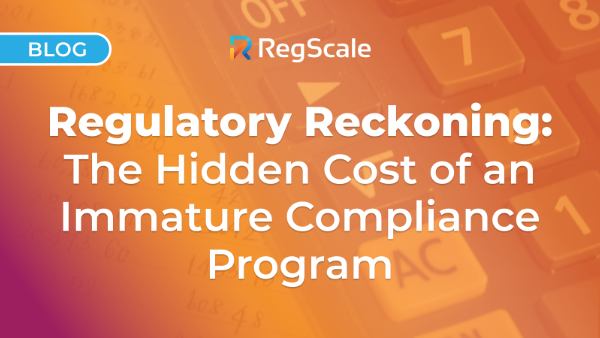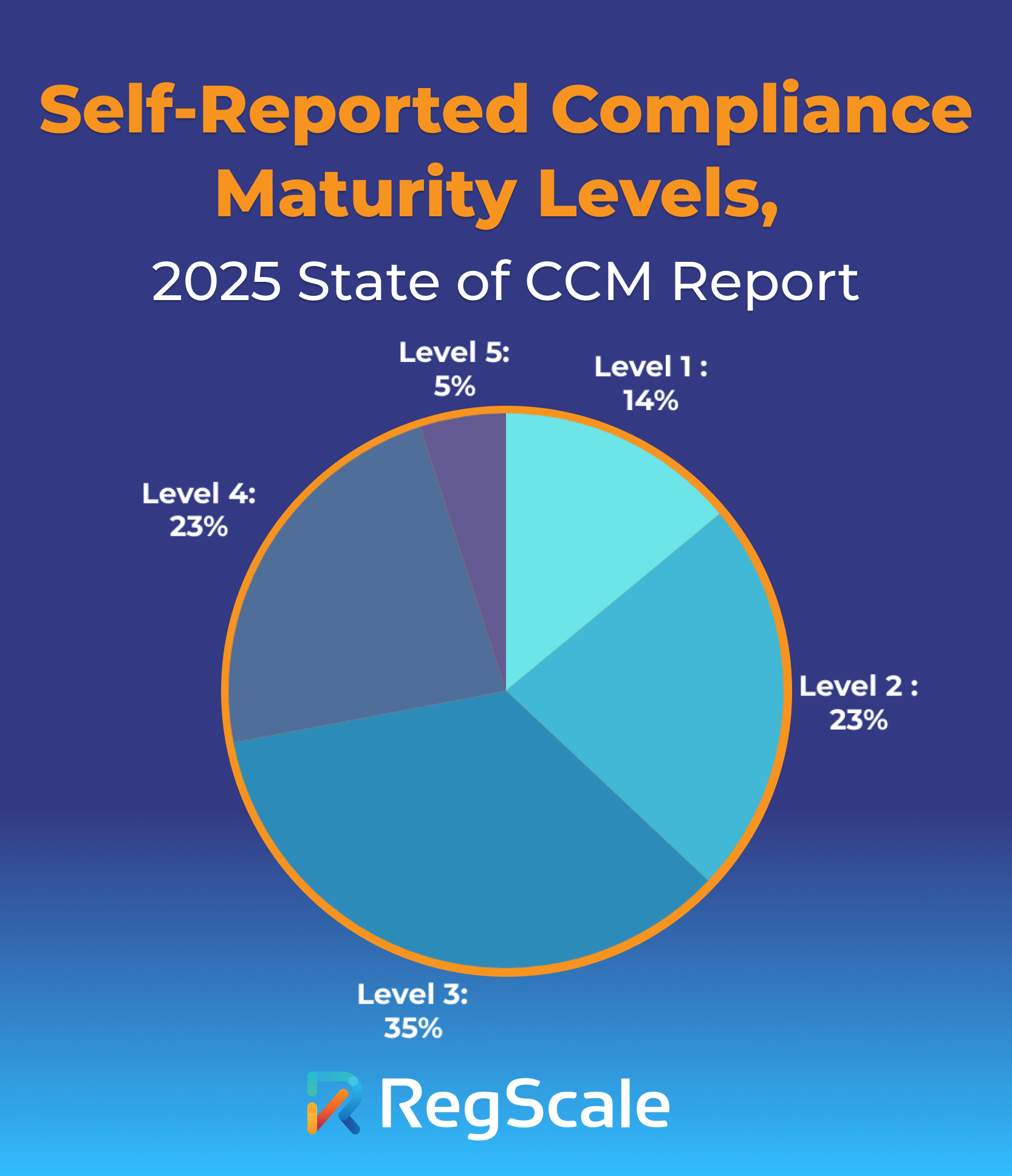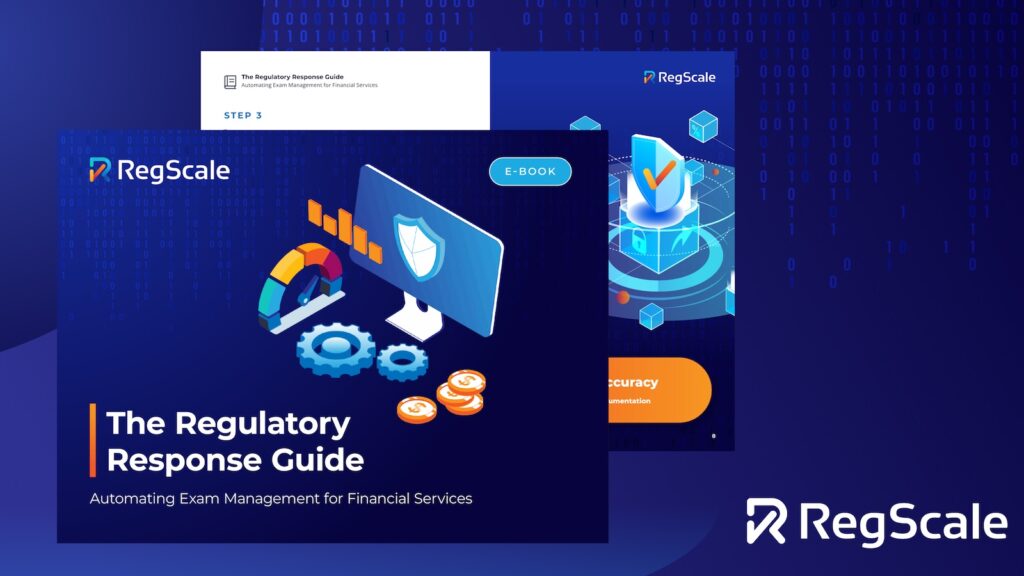Regulatory Reckoning: The Hidden Cost of an Immature Compliance Program

Remember when it was enough for companies just to have a compliance program, any compliance program?
Those days are over. Permanently.
Today, organizations face mounting pressure to demonstrate not bare-bones compliance but full maturity in their approach to managing regulatory requirements and security controls. It’s not enough to check boxes; you have to have repeatable, continuous, optimized processes in place.
Mature compliance programs share critical elements: they adapt swiftly to regulatory changes, identify vulnerabilities before they become breaches, and systematically reduce both risk exposure and operational costs. Their controls will be integrated across the organization (not siloed), and they will almost certainly leverage automation to reduce manual effort and human error. They shift the paradigm from “checking boxes” — a reactive, resource-draining exercise — to sustainable processes that protect the organization and enable business growth.
The benefits are obvious, but companies are still struggling to advance their compliance maturity. CISOs and compliance leaders have a clear picture of where they need to end up but no path for getting there. Read on for research about the top barriers that CISOs are encountering — and for practical steps that organizations can take to mature their compliance programs with limited resources.
Maturity models explained
To mature your compliance program, you first have to understand how compliance maturity is measured. Different organizations have released various tiered maturity models to help companies assess and improve their compliance, resilience, and cybersecurity programs. Here are a few:
- The National Institute of Standards and Technology (NIST) CSF 2.0 offers a tiered cybersecurity maturity model.
- Carnegie Mellon University offers the CERT Resilience Management Model.
- The US Department of Energy offers the Cybersecurity Capability Maturity Model (C2M2)
While every model is not focused exclusively on compliance, the NIST framework and others can still provide a clear roadmap for progress. Rather than portraying cyber maturity as a nebulous goal, these frameworks break it down into concrete, achievable steps, allowing organizations to set realistic targets and measure their improvements over time.
Compliance maturity isn’t about perfection — it’s about continuous improvement. Even businesses with limited resources can make meaningful progress by identifying their current tier and focusing on moving to the next one.
What’s standing between CISOs and a top-tier compliance program?
In our industry-first State of Continuous Controls Monitoring Report, we dove deep into the obstacles preventing CISOs from future-proofing their GRC programs. The research revealed telling insights from nearly 200 CISOs across industries — particularly when we asked them to evaluate the maturity of their current compliance program on a scale from 1 to 5.

The largest segment — 35% of respondents — placed themselves at level 3, describing their programs as defined, standardized, and structured. In other words, many organizations have established formal compliance processes but haven’t optimized them yet.
On the upper end of the spectrum, only about one-fifth (23%) of CISOs rated their programs at level 4, which involves using measurable metrics to support audit and risk mitigation. And a miniscule 5% of respondents rated themselves at level 5, which involves having continuously improving, optimized compliance processes.
Unsurprisingly, many organizations haven’t advanced their compliance maturity that far. Nearly a quarter of CISOs (23%) rated their programs at level 2, which involves established, documented, and repeatable (but not optimized or fully efficient) processes. Meanwhile, 14% classified themselves at level 1, in the initial ad hoc stage of compliance.
For those organizations at the lower end of the maturity scale (levels 1 and 2), almost half cited insufficient personnel or resources as their primary barrier to maturity— a resource gap that represents a significant and ongoing challenge in GRC.
The impact of these maturity challenges can be significant. More than half of the CISOs surveyed (52%) noted that program maturity was a significant factor in whether or not they could meet regulatory requirements.
Overall, these numbers reveal a compliance landscape where most organizations have progressed beyond ad hoc approaches but are still falling short of the continuous improvement and optimization that are needed for truly mature programs. The data points to a clear gap between where organizations currently are and where they want to be in their compliance journey.
Charting the path forward
There is a solution. But most CISOs haven’t adopted it yet.
The data from the State of CCM Report revealed that CISOs overwhelmingly acknowledge the burden of tedious compliance processes (80% noted that reducing manual processes was the biggest opportunity for automation). But their technology adoption is lagging.
Only 18% of security leaders report using generative AI within their compliance programs, despite its potential to streamline documentation and analysis. And only 13% of CISOs have begun adopting or plan to adopt compliance as code with languages like OSCAL or OCSF. (We recently explored the reluctance around using AI tools for GRC in our deep-dive CCM webinar, including the uncertainty surrounding how AI handles sensitive compliance data.)
The AI adoption gap represents a major missed opportunity for organizations struggling with compliance maturity. Intelligent, AI-enabled platforms can dramatically transform compliance programs, slashing manual processes and improving accuracy across the board. Consider the time and cost savings that organizations have seen with RegScale’s AI-powered platform:
- 60% reduction in audit prep and response time
- 92% less effort required to write control implementation statements
- 80% higher accuracy in control documentation
By automating routine tasks and improving documentation accuracy, the right automation platform helps even the most resource-strapped compliance teams do more with less.
If there’s a silver lining here, it’s that CISOs show strong interest in incorporating automation, with 94% saying they believe Continuous Controls Monitoring will improve both compliance and security outcomes for their organization.
Takeaways
If you’re looking to advance your compliance maturity, the message is clear. Strategic tech adoption — particularly AI-enabled solutions, intelligent automation, and Continuous Controls Monitoring — is the path forward. Regardless of the resource or staff constraints they’re facing, the organizations that embrace these tools will be best positioned to move up the maturity scale.
As regulatory requirements continue to evolve and multiply, the gap between organizations with mature, AI-enabled compliance programs and those still relying on manual processes will only widen. The time to bridge that gap is now.
To learn more, download the full State of CCM Report or check out our other GRC resources.
Ready to get started?
Choose the path that is right for you!
Skip the line
My organization doesn’t have GRC tools yet and I am ready to start automating my compliance with continuous monitoring pipelines now.
Supercharge
My organization already has legacy compliance software, but I want to automate many of the manual processes that feed it.
